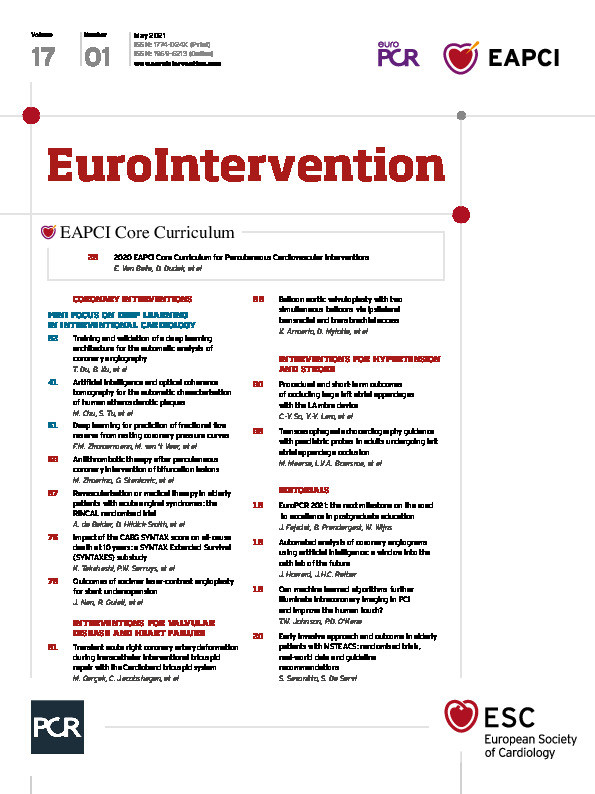Intravascular optical coherence tomography (IVOCT) is a mature technology although its adoption remains limited in most regions. An international survey in 20181 observed that >50% of European respondents undertook intracoronary imaging (ICI) in <5% of patients, compared with >95% of Japanese respondents who reported imaging use in >15% of patients (the reality being that >90% of all Japanese procedures are image guided). This stark contrast may be based on reimbursement. Interestingly, however, increasing PCI experience was associated with an increased adoption of imaging. This observation is consistent with our own experience that greater adoption of ICI has highlighted significant challenges in the interpretation of the coronary angiogram. “Lumenography” cannot reliably provide effective identification of calcific or lipidic plaque. Consequently, plaque modification and stent landing-site selection are purely at the physician’s discretion. Systematic use of ICI can guide decision making, stent selection and optimisation better, with a positive impact on outcomes2. However, it is important to acknowledge that studies of image-guided intervention are challenged by operator adherence to optimisation criteria, failing in up to half of patients3. Much of this failure represents disease complexity; however, core lab analysis highlights deficiencies in operator identification of tissue components, such as external elastic lamina.
Beyond this, IVOCT characterisation of plaque components has been shown to predict future events. The CLIMA study demonstrated that the combination of a minimum lumen area <3.5 mm2, fibrous cap <75 µm, lipid arc >180° and macrophages was independently predictive of cardiac death or target segment myocardial infarction (MI) with a hazard ratio of 7.54 (95% CI: 3.1-18.6)4. Similarly, the recently presented COMBINE OCT-FFR study demonstrated that identification of thin-cap fibroatheroma, despite absence of ischaemia (FFR >0.80), was predictive of a composite of cardiac mortality, target vessel MI, clinically driven target lesion revascularisation and unstable angina at 18 months, with a hazard ratio of 4.6 (presented by Elvin Kedhi at TCT Connect 2020, October 14). Tissue components including cholesterol clefts, lipidic plaque, neovascularisation and macrophage were more commonly identified in event-prone lesions. These data suggest that plaque characterisation and identification of vulnerable plaque may facilitate targeted therapy, passifying the plaque and avoiding future events.
The challenge remains adoption of ICI during routine PCI. The EAPCI/CVIT survey identified a lack of time, cost and limited training/education as the most frequent obstacles to imaging use1. Our personal view is that the lack of education and an inability to interpret IVOCT confidently represent the greatest barrier. Consequently, harnessing artificial intelligence (AI)-guided image interpretation could transform the approach for PCI operators less experienced in image guidance who are willing to learn.
In this issue of EuroIntervention, Chu and colleagues provide validation of an automated tool for plaque characterisation in IVOCT using AI, with a processing time <25 seconds, suggesting potential real-time clinical utility5.
An AI model using a convolutional neural network was trained on a large data set of IVOCT pullbacks, undertaken in stable patients from three previous studies. Over 11,000 OCT frames were annotated by two highly experienced IVOCT analysts in order to delineate lumen contours, internal elastic lamina, non-tissue parts and plaque components, including fibrous tissue, lipidic pool or calcium, in addition to markers of plaque instability and inflammation, including macrophage, cholesterol crystals or micro-vessels. Internal evaluation of a test data set demonstrated excellent model performance with best segmentation of fibrous, followed by calcific and then lipidic plaque. Interestingly, the model struggled with detection of macrophage, with a Dice coefficient of 0.489.
Subsequently, the model was tested on an externally derived series of OCT runs. Firstly, the sample was assessed by an expert panel of IVOCT users, from three highly respected core labs. Impressively, consensus on plaque characterisation was achieved in 99% of plaque regions. Unanimous agreement was observed in 81%, most frequently for cholesterol crystals, then calcific plaque, fibrous plaque, macrophage and then lipidic plaque. Despite the limitations of characterising attenuated plaque components, diagnostic accuracy in the external validation was achieved in 86.6% of 598 tissue regions, with best identification of fibrous plaque over lipidic and then calcific plaque.
It is important to recognise that both machine and humans found interpretation of plaque components with attenuating properties most challenging. However, the inter-observer agreement for both macrophage and lipid was impressively high amongst expert users (81.8% and 73.7%, respectively). This suggests that human interpretation incorporates more than simple image recognition, instead combining the image with interpretation of the backscatter/attenuation characteristics plus association with neighbouring lipidic plaque. However, it is unlikely that this expert user interpretation of an individual OCT frame was undertaken in 0.07±0.01 seconds. Image interpretation is further enhanced by evaluating sequential frames, rather than isolated frame analysis. The AI model tested has acknowledged this fact, adopting “pseudo-3D input”.
The validation of this AI-based characterisation tool should be extended to patients presenting with acute coronary syndrome (ACS), in whom markers of vulnerability are more frequently encountered, thereby challenging the accuracy of the existing tool. Despite this, it is our “imaging-biased” opinion that this exciting technology must be harnessed to aid wider adoption of plaque characterisation, procedural decision making and subsequent optimisation of medical therapies potentially to enhance treatment for patients with coronary artery disease. Further development of AI-based plaque characterisation may be achieved through integration of additional information, including attenuation/backscatter characteristics and profiling of the patient including comorbidities, biomarkers and gene profiling.
Undoubtedly, the greatest limitations to adopting an invasive imaging strategy in routine clinical practice are lack of time, money and training1. AI provides a solution for limited time and training assuming that a probe has been wielded. Now all we need to do is to find a machine that can print money and persuade the majority of interventional cardiologists to look beyond the angiogram!
Conflict of interest statement
T. Johnson has received speaker fees and consultancy/advisory fees from Abbott Vascular, Boston Scientific and Terumo. P. O’Kane has received speaker fees from Abbott Vascular, Terumo, and Philips in the last 36 months.
Supplementary data
To read the full content of this article, please download the PDF.

